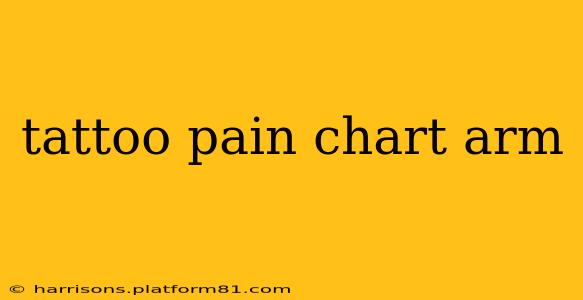Getting a tattoo is a deeply personal experience, and a significant part of that experience is the pain involved. While the beauty and artistry of tattoos are undeniable, understanding the pain levels associated with different areas of the body, especially the arm, can help you prepare mentally and physically. This guide will walk you through a tattoo pain chart focusing on the arm, addressing common questions and concerns.
Pain tolerance is subjective, varying greatly from person to person. What one person finds mildly uncomfortable, another may find excruciating. This chart offers a general guideline based on common experiences and should not be considered definitive. Several factors influence pain perception, including:
- Individual pain tolerance: This is the most significant variable.
- Tattoo artist technique: A skilled artist minimizes pain through proper needle depth and consistent speed.
- Aftercare: Proper aftercare reduces inflammation and discomfort.
- Skin thickness and sensitivity: Thinner skin areas tend to be more sensitive.
- Underlying health conditions: Certain conditions can affect pain tolerance.
Understanding the Arm's Pain Sensitivity
The arm isn't a single, uniform area when it comes to tattoo pain. Different parts of the arm have varying levels of nerve endings and skin thickness, leading to distinct pain experiences.
Inner Arm (Biceps/Triceps): This area generally receives a lower pain rating. The skin tends to be thicker and less sensitive than other parts of the arm. Many consider it relatively easy to tolerate.
Outer Arm (Forearm): The forearm presents a moderate pain level. While not overly painful, it’s more sensitive than the biceps/triceps area. Bony areas may feel more intense.
Elbow: The elbow is a bony area with thinner skin and many nerve endings, making it one of the more painful areas to get tattooed on the arm.
Wrist: Similar to the elbow, the wrist has thin skin and numerous nerve endings. Expect a higher pain level here, especially on the inner wrist.
Shoulder: The shoulder area is complex, involving areas of thick and thin skin. You might experience varying degrees of pain, with some areas being more sensitive than others.
What are the most painful areas to get a tattoo on your arm?
The most painful areas on the arm to get tattooed are generally considered to be the elbow and wrist. These areas have thinner skin, are close to bone, and are highly concentrated with nerve endings. The inner elbow, in particular, tends to be cited as especially sensitive. The shoulder can also be quite painful, depending on the specific location.
Is the inner arm less painful than the outer arm for tattoos?
Yes, generally, the inner arm (biceps and triceps) is considered less painful than the outer arm (forearm) for tattoos. This is due to the thicker skin and fewer nerve endings in the inner arm compared to the outer arm.
How can I minimize tattoo pain on my arm?
Several strategies can help minimize pain during your arm tattoo:
- Choose an experienced artist: A skilled artist knows how to minimize pain and discomfort.
- Communicate with your artist: Don't hesitate to tell them if you're experiencing too much pain.
- Take breaks: Your artist should incorporate breaks into the tattooing process, allowing your skin to recover.
- Eat a good meal beforehand: Low blood sugar can lower your pain tolerance.
- Stay hydrated: Hydration is essential for overall well-being and can influence pain perception.
- Consider topical numbing cream: Talk to your artist about using a numbing cream; however, it's crucial to discuss this beforehand, as some artists may not use them.
- Manage anxiety: Anxiety can heighten pain perception. Relaxation techniques can be helpful.
Is it better to get a large tattoo or a small tattoo on your arm for pain?
There's no single answer to this. A large tattoo will obviously take longer, increasing overall exposure to pain. However, a small tattoo in a very sensitive area (like the inner elbow) might be more intensely painful than a larger tattoo in a less sensitive area (like the outer bicep). The location and size need to be considered together.
Remember, this information is a general guideline. Your individual experience may vary. The most crucial step is to choose a reputable and experienced artist, communicate openly about your comfort levels, and be prepared for the sensation. The end result – your beautiful new tattoo – will be well worth it!
